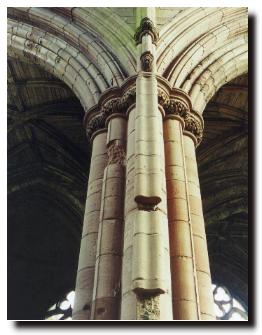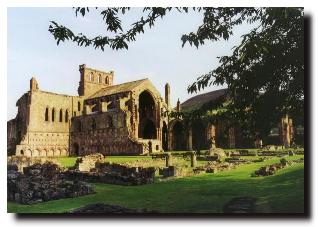 St Aidan of Lindesfarne in Northumberland first established a monastery at Old Melrose, to the east of the present town of Melrose, around 650AD. St Cuthbert, a shepherd from the Lammermuir Hills, was an early novice at the abbey. But it was King David I who invited Cistercian monks in 1136 to rebuild the abbey (the original had been destroyed by Kenneth MacAlpin 200 years earlier) but they decided to create a new building at Little Fordell (now Melrose).
St Aidan of Lindesfarne in Northumberland first established a monastery at Old Melrose, to the east of the present town of Melrose, around 650AD. St Cuthbert, a shepherd from the Lammermuir Hills, was an early novice at the abbey. But it was King David I who invited Cistercian monks in 1136 to rebuild the abbey (the original had been destroyed by Kenneth MacAlpin 200 years earlier) but they decided to create a new building at Little Fordell (now Melrose).
The abbey prospered as a result of endowments of land and other assets and Melrose eventually became one of Scotland's wealthiest medieval monasteries. King Alexander II, who died on the island of Kerrera, near Oban, ordered on his deathbed that he should be buried in Melrose.
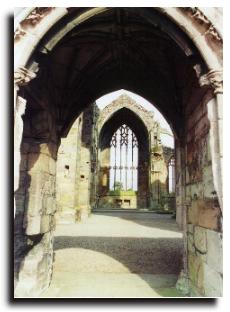 But the peace of the abbey was shattered in 1296 with the invasion of Scotland by King Edward I of England and again in 1322 when Edward II sacked the building. Robert the Bruce assisted in the rebuilding of the abbey. Although King Robert was buried at Dunfermline Abbey, his heart was buried at Melrose Abbey (though some chroniclers claim that it got there only after Sir James Douglas failed to take it to the Holy Land).
But the peace of the abbey was shattered in 1296 with the invasion of Scotland by King Edward I of England and again in 1322 when Edward II sacked the building. Robert the Bruce assisted in the rebuilding of the abbey. Although King Robert was buried at Dunfermline Abbey, his heart was buried at Melrose Abbey (though some chroniclers claim that it got there only after Sir James Douglas failed to take it to the Holy Land).
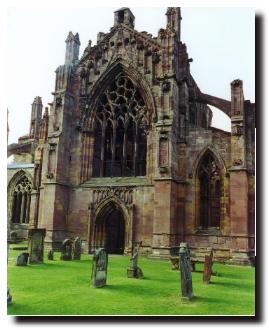 Later in the 14th century, an attempt by Scotland to assist France, led to Richard II invading Scotland and Melrose abbey was one of the many places burnt to the ground. It is the abbey which was built over the next 100 years which we see mainly today. The ornamentation was rich, the craftsmanship superb, the sandstone quarried from the local Eildon Hills. Surprisingly, it was Richard II and English masons who started the work (Richard thought the Borders had become part of England).
Later in the 14th century, an attempt by Scotland to assist France, led to Richard II invading Scotland and Melrose abbey was one of the many places burnt to the ground. It is the abbey which was built over the next 100 years which we see mainly today. The ornamentation was rich, the craftsmanship superb, the sandstone quarried from the local Eildon Hills. Surprisingly, it was Richard II and English masons who started the work (Richard thought the Borders had become part of England).
Damage was again done to the building during King Henry VIII's "Rough Wooing" - demands that Edward VI of England (aged 10) should marry Mary Queen of Scots (aged 5). With the Reformation of the church not long afterwards, the abbey fell into further disrepair as there were no longer any monks to look after the building.
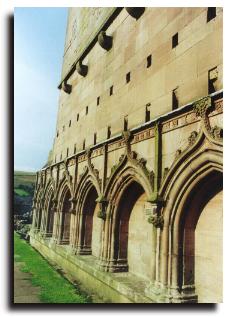 Despite the centuries of neglect, there are soaring, decorated arches, vaulted ceilings, elegant tracery on the south transept and many carvings (some of which are humorous - like the pig playing the bagpipes and the grumpy fellow bearing the inscription "He suffered because he himself willed it"). And Robert the Bruce's heart, reburied on 24 June 1996 (the anniversary of Bruce's victory at Bannockburn in 1314) now has a plaque with an inscription from Barbour's "The Brus" reading "A noble hart may have no ease, gif freedom failye" Translated, this means "A noble heart cannot be at peace if freedom is lacking" It incorporates a carving of a heart entwined in the Saltire, the basis of Scotland's national flag.
Despite the centuries of neglect, there are soaring, decorated arches, vaulted ceilings, elegant tracery on the south transept and many carvings (some of which are humorous - like the pig playing the bagpipes and the grumpy fellow bearing the inscription "He suffered because he himself willed it"). And Robert the Bruce's heart, reburied on 24 June 1996 (the anniversary of Bruce's victory at Bannockburn in 1314) now has a plaque with an inscription from Barbour's "The Brus" reading "A noble hart may have no ease, gif freedom failye" Translated, this means "A noble heart cannot be at peace if freedom is lacking" It incorporates a carving of a heart entwined in the Saltire, the basis of Scotland's national flag. 